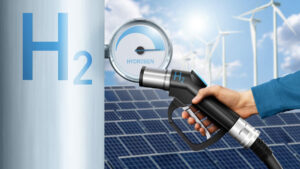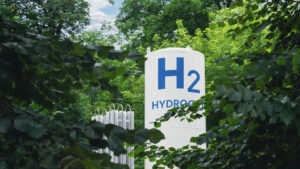Emission Control: Australia is stomping on the accelerator in its hydrogen push

Speeding up on hydrogen. Pic: via Getty Images
Emission Control is Stockhead’s fortnightly take on all the big news surrounding developments in renewable energy.
While there are some who still think that renewable hydrogen would make a great fuel for consumer vehicles (despite the massive headstart that battery electric vehicles already have), Australia appears to be betting that it is better used to reduce industry emissions.
This is in line with a general kind of consensus that the most common gas in the universe is ideally suited for use in hard-to-abate sectors such as steel.
As part of this push, the Australian Renewable Energy Agency (ARENA) is investing $32.1m into Rio Tinto and Sumitomo Corporation’s ground-breaking $111.1 million renewable hydrogen calcination trial at the Yarwun Alumina Refinery.
Success has the potential to abate a significant amount of emissions given that the energy intensive process of refining alumina accounts for about 3% of Australia’s emissions, or more than twice the energy used by Tasmania.
Notably, using renewable hydrogen could eliminate emissions from the calcination process, which accounts for up to 30% of alumina refining emissions.
ARENA’s investment will assist with the installation of a 2.5 megawatt onsite electrolyser, a hydrogen storage facility, and a hydrogen-capable burner to retrofit one of the refinery’s four calciners – which are the large industrial ovens used in alumina refining.
Commissioning is expected in 2025 and will form a key role in the wider transformation and decarbonisation of Gladstone’s industrial hub.
“Australia is the world’s largest exporter of alumina and cutting emissions from our alumina refining will ensure this industry can continue to thrive in a decarbonising global economy – where 139 countries have net zero by 2050 commitments,” Minister for Climate Change and Energy Chris Bowen noted.
Nor is that the only step that is being taken.
The Australian Government has also committed $70m to support a renewable hydrogen hub that Origin Energy and Orica are developing.
Funding will build the infrastructure needed to produce up to 5,500t of renewable hydrogen each year, much of which will be used by Orica’s ammonia and ammonium nitrate facility to help make their products emission-free.
Hydrogen will also be made available for refuelling hydrogen buses and trucks at the hub.
Adding further significance, the renewable hydrogen will be produced using a 55MW electrolyser, which is over five times larger than the biggest electrolyser currently at final investment decision.
Construction of the facility is targeted to begin in 2025 with operations expected to commence in 2026.
On that note
And while we have Orica on call, the Australia-based multinational has started using a tertiary catalyst abatement technology to capture nitrous oxide – a greenhouse gas 265 times more potent than carbon dioxide and a by-product of explosives production, which will reduce emissions from its Kooragang Island explosive manufacturing plant by 48%.
Development of the $37 million decarbonisation project was assisted by a $25m investment from the Clean Energy Finance Corporation.
Orica managing director Sanjeev Gandhi said the project clearly demonstrates that with the right policy settings and corporate commitments, emissions reduction is possible in hard-to-abate industries of our economy.
In a nod to the Government’s Safeguard reforms, which certainly isn’t on the nice list of gas players, he added that it provided policy certainty for Orica to continue accelerating its decarbonisation plans with confidence.
At the state level, Queensland has signed a heads of agreement with South Korea’s Han-Ho Hydrogen Consortium to advance the latter’s export scale green hydrogen hub project in North Queensland from concept to feasibility study.
The study will be supported by $8.5 million investment by Queensland Government towards making Abbot Point into a hydrogen export super hub capable of producing up to 1.8 million tonnes of green ammonia.
Renewable energy growth is continuing
Meanwhile, Australia has wrapped up the 2023 financial year with renewable energy making up a record 36.8% of its share of power on the main grid while coal’s contribution has dropped to 57%, its lowest this century.
Data from OpenNEM has shown that of the 207 terawatt hours of electricity produced on the National Electricity Market in 2022/23, some 77TWh came from renewable sources.
Wind was the biggest renewable contributor with 13% of the overall production while rooftop solar contributed 10%, utility scale solar another 6.1% and hydro rounding up the numbers with another 7.6%.
Now while the increase from 33.3% to 36.8% is fantastic progress, it reflects just how far Australia has to go to achieve its targeted 82% renewable share by 2030.
So it’s probably a good thing that the Government has declared Australia’s second offshore wind zone off Hunter, New South Wales.
While the 1,800km2 area between Swansea and Port Stephens is smaller than originally proposed – due to opposition from some residents, the strong, consistent winds make this area ideally suited for offshore wind power.
Indeed the government estimated that it could support up to 5 gigawatts of wind power, enough to power an estimated 4.2 million homes and local industry.
That this is close to the heartland of heavy industry is another big plus as any wind developments could support future onshore manufacturing and energy security in the state.
Being seen to be taking action in this way is probably a good thing when you consider that more than two-thirds of Australians are concerned about the long-term threat of climate change to our way of life according to research company Ipsos’ 2023 Climate Change Report.
The same report found that renewable energy remains the top environmental issue Australians want action on while a third think the Federal Government is not doing enough to address climate change – though this is admittedly down from 44% in 2022.
Australians also believe that taking action on coal, oil and gas, energy and waste can make the most impact on climate change while six in 10 say that Australia should be a global leader in emissions reductions.
This will not be an easy objective to meet with the US investing significant sums into its decarbonisation efforts while America, the European Union and Japan have announced US$3 trillion in green technology spending with over US$150 billion announced for building new energy technology commercial scale pilot plants.
But acting now could certainly place us at the forefront of the pack, which is really where you want to be.
Emissions reduction on the ASX
While big moves are undoubtedly significant in reducing emissions, every little bit counts and these ASX juniors are certainly looking to play their part.
ReNu Energy (ASX:RNE)
Progress is being made by ReNu’s wholly-owned subsidiary Countrywide Hydrogen towards making a final investment decision for its Tasmanian green hydrogen projects with the selection of suppliers for electrolysers, hydrogen refuelling stations and construction contractors.
Along with Wood, the company has selected Plug Power as the preferred contractor to supply 5MW proton exchange membrane electrolysers at its Brighton and Western Junction sites.
Meanwhile, Fabrum has been selected as the preferred contractor to provide its H35 hydrogen refuelling stations at the Brighton, Western Junction and Burnie sites and Wasco Australia selected as the construction contractor to work with Fabrum on the construction and balance of works on the projects.
The three projects will source renewable power from the state’s grid before sourcing supply from behind-the-meter solar and power purchase agreements from wind, solar and hydro operators.
Each electrolyser project is designed to allow for the installation of a second 5MW electrolyser when demand at either site exceeds two tonnes of hydrogen per day.
Additionally, the HRS design allows for having an equivalent fleet of 70 fuel cell electric trucks refuelling at each site per day and for the future installation of additional storage and compression to double the capacity of the stations.
Hazer Group (ASX:HZR)
Over in Canada, Hazer and its partner FortisBC have assumed joint operatorship of a proposed 2,500t per annum hydrogen project in Vancouver, British Columbia, from Suncor Energy.
The engineering design for the project is scheduled to be completed in the current quarter with a final investment decision expected in the first half of 2024 and start-up targeted for late 2025/early 2026.
FortisBC, a leading Canadian energy utility owning significant natural gas, electric transmission and distribution infrastructure and a key partner will supply the natural gas feedstock to the project and purchase the hydrogen from the facility for blending into the Vancouver natural gas pipeline network.
Hazer will in turn provide its proprietary process technology that enables the conversion of natural gas into hydrogen and graphite with very low emissions.
Related Topics

UNLOCK INSIGHTS
Discover the untold stories of emerging ASX stocks.
Daily news and expert analysis, it's free to subscribe.
By proceeding, you confirm you understand that we handle personal information in accordance with our Privacy Policy.








